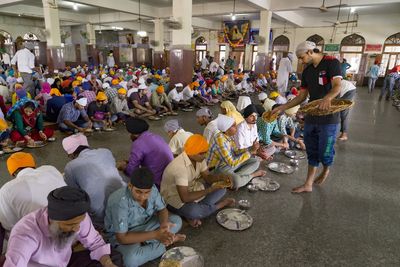They say there is no such thing as a free lunch. There could be some, though. India, 'the land of bikshuks’, has a tradition of serving free food to rank strangers. The Bhikshuka Upanishad lays down the lifestyle of four types of mendicants, who live mostly on alms. India is also the land of the Golden Temple in Amritsar, which has the world’s largest kitchen where nearly a lakh people eat everyday. ISKON, the organisation of Krishna devotees, has a concept of community kitchen called akshayapatram, and history tells us that we have always been feeding, not feeding on others.
Last week, I attended the inauguration of the Janakeeya Bhakshna Shala (JBS)—which roughly translates into ‘people’s dining hall’—conceptualised by Kerala’s finance minister Dr Thomas Isaac. The first one of these food centres has been set up in his constituency of Allepey, on National Highway 66.
In evolutionary biology, an organism is said to behave altruistically when its behaviour benefits other organisms, even at a cost to itself. In The Descent of Man, Charles Darwin discussed the origin of altruistic and self-sacrificial behaviour among human beings. Studies inspired by Darwin have proved that the capacity to be caring, generous and being kind have been built into the brains, bodies, genes and social practices of human beings.
But then, how do you sustain altruism? Let us look at the mechanics of JBS. It was initiated by eight people, who worked day in and day out to provide food to nearby hospitals. Now, with the help of the Kerala State Financial Enterprices, it has started this centre spread over 1,500sq.ft. I was talking to local artists and common folk and they took me to the backyard of the JBS building and showed me a patch of land—nearly four acres—that has been donated by a generous man to cultivate vegetables for and by JBS.
It made me think about the near total absence of Indian philanthropists (if you were to stack up the number of philanthropists, against the number of Indian billionaires, then you will get the picture). Of course, philanthropy in India means setting up schools or temples in the name of family members. Philanthropy is more of an ego-boosting exercise. The rich in India seldom open their wallets, but to build collections of jewellery, fast cars, yachts, private jets and ostentatious farm houses.
While on a drive down the Mattanchery Bazar road, I saw yet another heritage structure brought down by moneybags, and it brought back memories. I began wondering how they are able to execute their wishes with impunity. Isn’t there any policy that protects the heritage zone? Kochi and Mattanchery area have been declared as heritage zones by the UNESCO. And, just the other day, I was reading about how a new project, commissioned by the Foundation for Jewish Heritage, has identified synagogues built before the second World War, from Cork in Ireland in the west to Vladivostok in Russia in the east. Each has been catalogued with construction dates and materials, the Jewish community it served, its present use and condition, and a “significance rating”. Simon Schama will launch the project with the backing of more than 40 high-profile supporters including architect Daniel Libeskind, television newsreader Natasha Kaplinsky and artist Anish Kapoor. Such a thing is possible only if we have an idea of what our heritage is, and only if we look beyond immediate short-term gains.
I have had the good luck to meet incredible people whose passion, intuition and inquisitiveness have taken them to their desired destinations. One such person is the 84-year-old Lady Helen Hamlyn. I met her last week. She was one of the first fashion designers to pass out from the Royal College of Art in 1963. And, now she preserves, protects and funds conservation. Three of the projects are in India: the Reis Magos Fort in Goa, the Nagaur Fort in Rajasthan and the Chittoor Palace in Kerala. Apparently she spots these places on her own, and is not approached by anyone in India or abroad. Altruists walk alone.
editor@theweek.in


